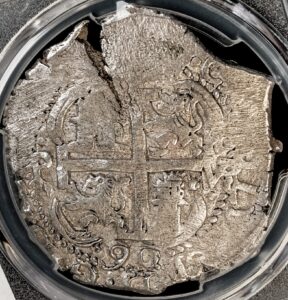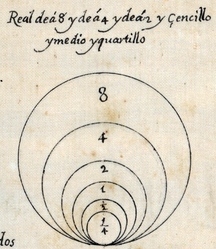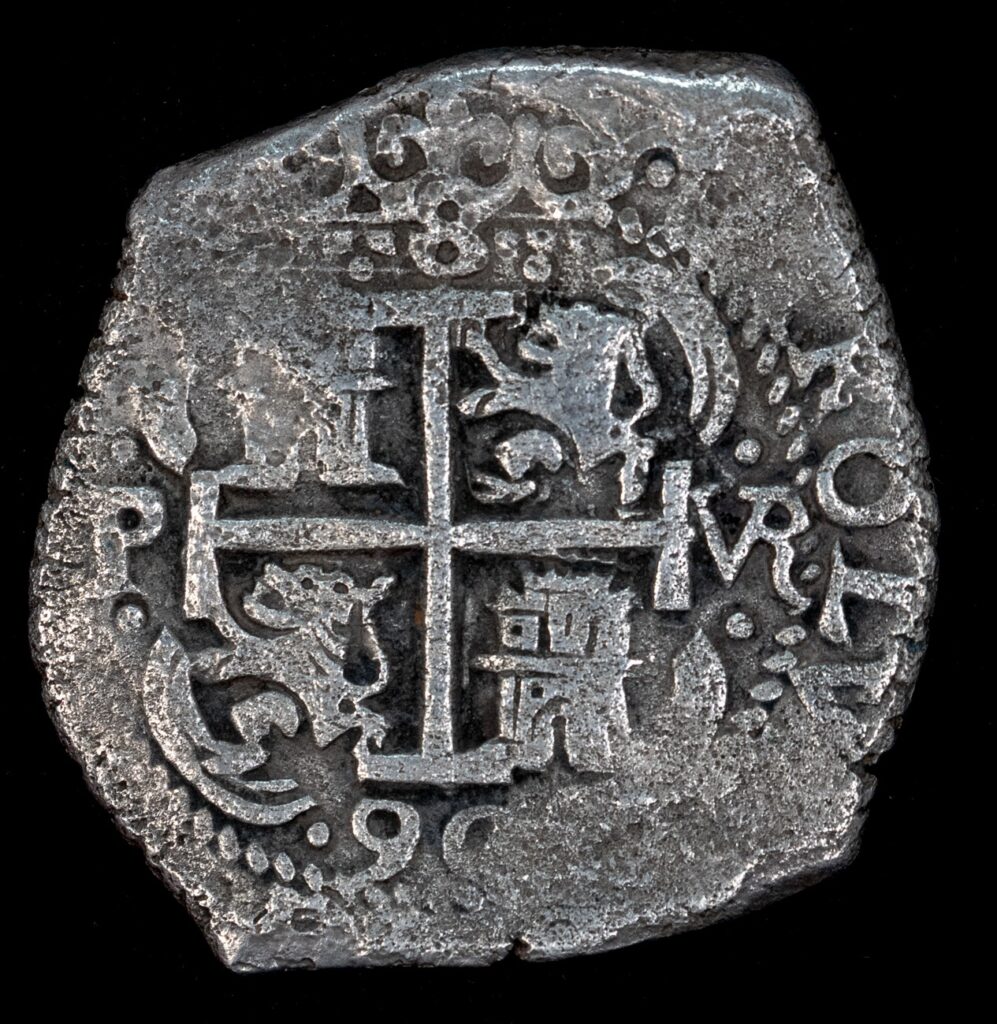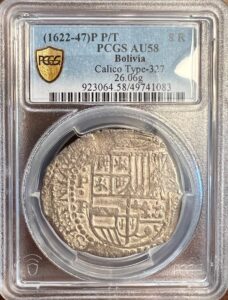When collecting coins in general, it is very important to educate yourself prior to spending your hard-earned money, especially if you are considering buying expensive raw coins that have not been professionally authenticated or graded. This is crucial when buying uncertified Spanish or Spanish Colonial cobs as there are many fakes out in the market today.
The Unique Characteristics of Cobs
 Most historians and numismatists believe that the word “Cob” comes from a Spanish phrase “cabo de barra”, which being interpreted means “end of the bar”. This is a reference on how these coins were made.
Most historians and numismatists believe that the word “Cob” comes from a Spanish phrase “cabo de barra”, which being interpreted means “end of the bar”. This is a reference on how these coins were made.
Cobs are hammer struck coins, which means that they are very irregular when it comes to shape, thickness uniformity, size, or completeness of die design. The process of minting a cob involved pouring molten silver or gold into a thin bar or strap, cutting it down, weighing it, and then clipping or chiseling small pieces off until the planchet (coin blank) reached the desired weight. The thickness of the bar or strap often depended on the denomination of the coin being minted. Smaller denominations such as ¼ Reales to two Reales were often poured very thin, while the larger 4 and 8 Reales denominations were poured thicker. Once the planchet was determined to be the correct weight, regardless of shape, it was ready to be struck.
First, the planchet was heated to soften it. Once the planchet was made malleable, it was positioned on a stationary wrought iron die held in place on a table or anvil. Then a handheld die was placed over the planchet and struck with a heavy hammer. This method often produced a number of flaws to the coin’s impression. The strike of the hammer and unevenness of the planchet often created planchet cracks, where the edge of the coin split apart. In cases where the actual die itself cracked, this would create a transposed raised crack that would imprint on the coin’s surface. Both types of cracks would result in the design details becoming obscured.
If the planchet was not heated enough or if the die alignment was off, the coin often had to be struck more than once in order for the design elements to imprint. This resulted in doubling of the strike and misorientation. Misorientation is when the obverse of the coin shows the top of the design at the 12 o’clock position and when the coin is flipped over, the top of the reverse design is shifted off center or upside down.
The last step in the minting process was to dip the cobs into a sulfuric acid bath, which removed any discoloration or toning from the heating process. This left beautiful and frosty bright surfaces.
When cobs were made, the most important criteria for the assayer in charge of the mint and the kings of Spain was the purity and the weight. After this, the coat of arms, Jerusalem cross, assayers initial, and mint mark. Overall shape or completeness of the designs were of little significance in comparison to purity and weight.
Denominations & Weights
 Silver cobs, known as Reales were mostly commonly produced in denominations of 1,2,4, and 8 Reales. These were minted during the reign of King Philip II (1556-1598), Philip III (1598-1621) and Philip IV (1621-1665). Cobs continued to be produced through the reigns of Charles II (1665-1700), Philip V (1700-1724 and 1725-1746), Louis I (1725), Ferdinand VI (1746-1759) and Charles III (1759-1788). Fractional cobs of a half real and quarter Reale were also minted, but these are less common.
Silver cobs, known as Reales were mostly commonly produced in denominations of 1,2,4, and 8 Reales. These were minted during the reign of King Philip II (1556-1598), Philip III (1598-1621) and Philip IV (1621-1665). Cobs continued to be produced through the reigns of Charles II (1665-1700), Philip V (1700-1724 and 1725-1746), Louis I (1725), Ferdinand VI (1746-1759) and Charles III (1759-1788). Fractional cobs of a half real and quarter Reale were also minted, but these are less common.
A one real was the equivalent of 1/8 of an 8 Reales or “Piece of Eight”. It is quite common to find pie shaped silver wedges cut from 8 Reales into 1 real weight pieces, where an 8 Reales was cut to make change.
One of the keys to determining the authenticity or value of a cob is the weight. If a cob is found to be grossly overweight or underweight, this may be an indication of a counterfeit. However, it was a common practice during the period when cobs were made for people to clip small pieces off or file the edges to accumulate the clippings and dust. There were even periods where assayers in Potosi, Bolivia conspired to defraud the Spanish monarchy by minting silver coins of lower silver content.
Silver cobs recovered from shipwrecks are typically well underweight, which is a direct result of silver loss from corrosion.
Here is a table that shows what the proper weight of silver cobs should weigh:
Silver Cobs Weight Scale
8 Reales = 27.47 grams
4 Reales = 13.73 grams
2 Reales = 6.87 grams
1 Reale = 3.43 grams
½ Reale = 1.72 grams
¼ Reale = .86 gram
NOTE: Keep in mind that scales used for weighing cobs were nowhere near as accurate as today’s digital scales. So, there is a margin of error when it comes to weight, so just because a cob may be slightly underweight doesn’t necessarily mean it has been clipped or altered or that it isn’t genuine.
 The general size of the different denominations varied, but in general, the size difference often followed this illustration from a 1657 Spanish document depicting relative sizes of Castilian silver coins from 8 Reales to a quarter real.
The general size of the different denominations varied, but in general, the size difference often followed this illustration from a 1657 Spanish document depicting relative sizes of Castilian silver coins from 8 Reales to a quarter real.
There are Endless Varieties!
 The dies used to manufacture cobs did not last long and often had to be replaced, reengraved, or repaired. This resulted in a vast array of die varieties, over dates, errors, and other irregularities. In some cases, if you look closely, you may discover obvious errors, such as the castles and lions being reversed, a number may be replaced with a letter that looks similar to a number, a denomination of a Roman numeral 2 might be replaced with the letter “Z” or “H” turned sideways, and so forth.
The dies used to manufacture cobs did not last long and often had to be replaced, reengraved, or repaired. This resulted in a vast array of die varieties, over dates, errors, and other irregularities. In some cases, if you look closely, you may discover obvious errors, such as the castles and lions being reversed, a number may be replaced with a letter that looks similar to a number, a denomination of a Roman numeral 2 might be replaced with the letter “Z” or “H” turned sideways, and so forth.
Silver cobs that are the most commonly collected from Spanish Colonial mints include:
Mexico City /Mexico, Lima / Peru , Potosí /Bolivia
Silver cobs that are the most commonly collected from mainland Spanish mints include:
Seville, Toledo, Madrid, Granada, Segovia, Valladolid
No two cobs are exactly the same, which makes each one unique in its own way. Cob enthusiasts collect all sorts of unusual varieties, including: types minted during the reign of certain kings, assayers, mints, errors, denominations, cobs shaped into animals or objects, and a wide range of unique die characteristics. Seeing that no two cobs are the same, makes collecting Spanish cobs really challenging and a lot of fun!
What Makes Certain Cobs More Valuable Than Others?
There are a number of factors to consider when determining value of coins, especially Spanish cobs and here are a few:
1) Rarity
Some cobs are considered very rare, which is one factor that will drive price and desirability. Rarity could come in the form of how many examples are known to exist, how many were originally minted, the condition or level of preservation, how much of the design elements are visible, etc. For example, you could have the most common date range of a cob in circulated condition with average details and it might be worth $200 to $300. However, you could have a similar cob from the same period and mint in uncirculated condition be worth thousands.
One way to determine how rare a cob might be is to see how many have been graded by PCGS or NGC. Each of these grading services maintain a population database of every coin they have graded. To check on the grading population of cobs graded by PCGS, visit www.pcgs.com. To check on the grading population of cobs graded by NGC, visit www.NGCcoin.com.
2) Provenance
 Cobs that are known to come from well-known private collections, hoards, or shipwrecks often carry significant premiums over similar pieces that are not attributed to anything noteworthy. For example, an 8 Reales minted in Potosi, Bolivia that shows signs of environmental damage may only be worth $250. However, if this same coin was attributed to a shipwreck such as the Nuestra Señora de Atocha, it could be worth over ten times the value of a similar coin that has no shipwreck attribution.
Cobs that are known to come from well-known private collections, hoards, or shipwrecks often carry significant premiums over similar pieces that are not attributed to anything noteworthy. For example, an 8 Reales minted in Potosi, Bolivia that shows signs of environmental damage may only be worth $250. However, if this same coin was attributed to a shipwreck such as the Nuestra Señora de Atocha, it could be worth over ten times the value of a similar coin that has no shipwreck attribution.
Keep in mind that there are certain shipwrecks that are much more desirable than others, so just because you have a coin recovered from a wreck, doesn’t always mean it’s rare or highly desirable. Popular shipwrecks such as the 1715 fleet, Atocha, Gilt Dragon, or Maravillas, will always demand a premium over lesser known wrecks.
3) Level of preservation and strike
 The level of preservation and quality of strike are probably the most important factors in determining values of cobs. In many cases, a cob that is in about uncirculated or uncirculated condition with a strong and well centered strike on both sides can demand prices well over similar types that may be of a rare mint or assayer or ones with provenance. The reason for this may be that there are more collectors interested in owning a coin that ranks up there with the finest examples known over an average coin that may only have rarity going for it.
The level of preservation and quality of strike are probably the most important factors in determining values of cobs. In many cases, a cob that is in about uncirculated or uncirculated condition with a strong and well centered strike on both sides can demand prices well over similar types that may be of a rare mint or assayer or ones with provenance. The reason for this may be that there are more collectors interested in owning a coin that ranks up there with the finest examples known over an average coin that may only have rarity going for it.
4) Overall eye appeal
 A large majority of cobs do not have much to offer in terms of eye appeal until they reach the higher tiers of the numismatic grading scales. However, beauty is in the eye of the beholder, and some may find a cob in circulated condition that shows a full shield and cross to be more desirable than one that is about uncirculated that lacks details. Toning also plays a significant role as there is a whole collector base who don’t care too much about rarity, provenance or strike, but love the colors that silver often displays when exposed to sulfur or other environmental elements that react with silver.
A large majority of cobs do not have much to offer in terms of eye appeal until they reach the higher tiers of the numismatic grading scales. However, beauty is in the eye of the beholder, and some may find a cob in circulated condition that shows a full shield and cross to be more desirable than one that is about uncirculated that lacks details. Toning also plays a significant role as there is a whole collector base who don’t care too much about rarity, provenance or strike, but love the colors that silver often displays when exposed to sulfur or other environmental elements that react with silver.
I always recommend that new collectors of Spanish or Spanish Colonial cobs should try to buy the best quality they can afford that includes one or more of the four desirability factors discussed. This will help the coin retain its value and make it far easier to sell later on.

Leave a Reply